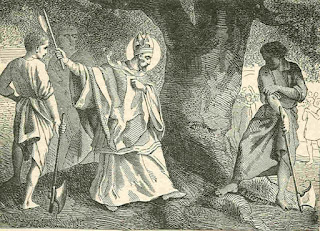In the ritual of knighthood, after the girding on of the new knight's sword, he receives a hard slap "so that he will remember what he is promising and the great burden he must carry and the great honour he is taking through the Order of Chivalry" (to paraphrase Ramon Llull's Book of the Order of Chivalry).
The blow or slap to the cheek was a part of many rituals.
The kings of Babylon—including Nebuchadnezzar himself—would submit themselves on the fourth day of the Babylonian new year to being struck on the cheek, reminding them of the importance of humility. [link] A priest in the Mesopotamian Akitu festival would slap the king and have him kneel before the statues of the god Marduk, to remind him that the gods are more powerful than kings. [link]
Some believe Jewish tradition includes a slap at times, with an added "Mazel Tov," as this writer tells. It is a token slap, not hard. Here, however, it is argued that it does not originate in the Torah and should not be considered Jewish tradition. "Official" or not, it still happens, apparently.
Benvenuto Cellini in his autobiography tells of his father striking him a hard blow specifically in order to cement in his memory the image of a salamander seen in the fire.
The Roman Catholic sacrament of Confirmation involved a light slap on the cheek in order to show the willingness of the confirmed to "suffer for their faith." The blow on the cheek appears in medieval liturgical books. It was officially removed from the ceremony in 1971.
The practice of using a light blow to the cheek to signify a change in a person's status—reminding them of humility, elevating them to knighthood or Catholic adulthood, etc.—has existed from ancient times through medieval and into modern times. Is a common origin likely? Did the Babylonian and Mesopotamian idea of the slap denoting humility inspire Judaism and lead to the New Testament saying, and did that get carried through the Middle Ages as part of not only knighthood but also confirming a Christian's standing as an adult? We can't be certain.
What we can be certain about is the ritual of knighthood, which was explained in detail. We'll look at that next time.














